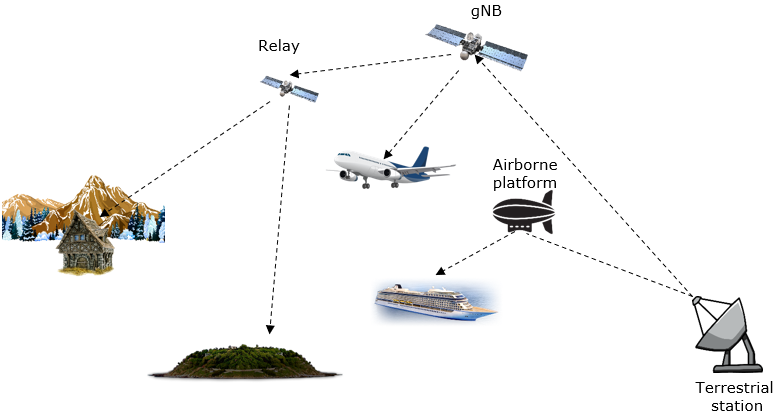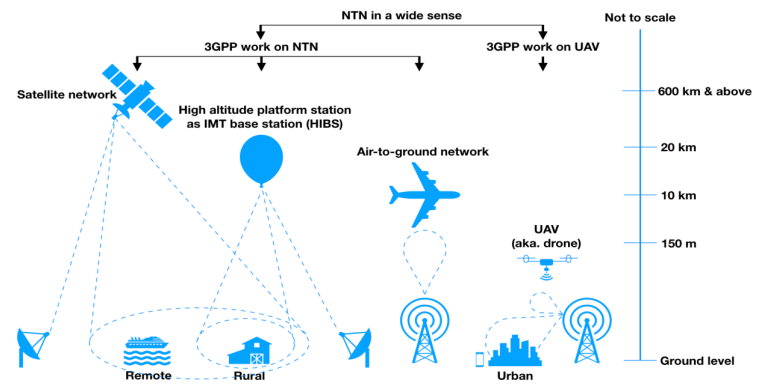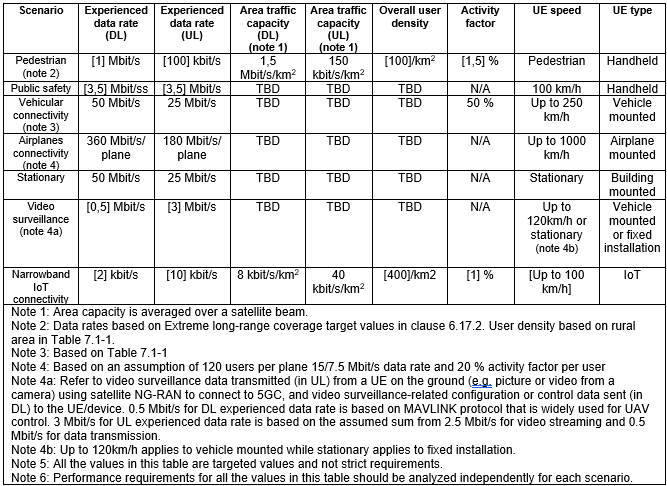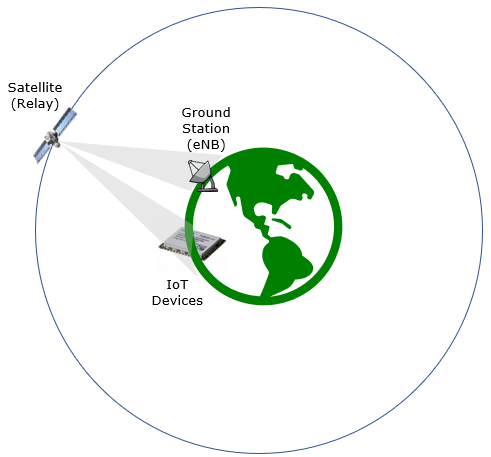|
5G/NR - NTN |
|||||||||||||||||||||||||||||||||||||||||||||||||||||||||||||||||||||
|
NTN (Non Terestrial Network)
The basic idea of NTN is obvious. It is to deliver 5G/NR service via space (satellite) or air (airborne platform) as illlustrated below.
The motivation is obvious as well. If it is realized as expected, it would be able to deliver the 5G service to those places where it is technically very difficult or cost too much to deliver with terrestrial network. Some examples of those places would be a remote area like deep forest that would be too costly with terestrial delivery, or far islands or ship that would be technically almost forbidden in terrestrial connection.
NOTE : The illustration shown above is consolidated representation of various deployment options described in various TRs in the reference section. If you want to get a little bit detailed diagram for each of the deployment plan separately, you may refer to 3GPP TR 38.821 V16.1.0
I found another well summarized illustration from this paper as shown below. It shows various different use cases and potential ground-to-airborne connection mechansm.
There would be no single clear-cut advantage (motivation) of adopting NTN over the existing (conventional) method. Just for brain storming purpose I will just list up all the possible idea that I can collect. Definately there would be more.. and something you don't agree
I personally am so eager to see this realized because one of those areas shown above is my dream place -:), but there would be many challenges to be overcome. Followings are a short list of those challenges. (NOTE : To foresee on those challenges, I think it would be helpful to investigate on the challenges that the satellite communication systems being depolyed and tested now (as of Feb 2021) and SpaceX Starlink can be a good example since there are so much informations are available. Even though it is not easy to find the details on challenges on the fancy looking system, it would be more helpful as an engineer to look for the challenges and see how those challenges gets resolved).
Latency : One obvious challenge that everybody can easily guess would be the long latency caused by pure physics. There is long distance between ground station/user terminal and the satellite. The speed of light is finite. So it would take a considerable amount of time (delay) for the radio wave to reach the user device. Of course, this latency would very depending on the altitude of the satellite. If the satellite is deployed on GEO(Geostationary Orbit), the delay would be huge. If they are deployed in LEO(Low Earth Orbit), the delay would be low (in some case it can be even shorter than what you experience with WiFi delivered by ground connection), but it would require huge cost to cover the wide area with LEO like StarLink.
Demand on Ground Stations/Integration with terrestrial core : Even though we can put the radio part (e.g, gNB, Relay etc) up in the space, the core network is (should be) on the ground. It mean that the satellite or airborne platform should be connected to ground station at some point. The question is how far it can get connected to the ground station. Obviously there would be a certain limit in distances in which a satellite can reach a ground station. As a result, we would need a lot of ground station as well as satellite if we want to cover wide area. In some cases, it will be very challenging to set a ground station. For example, if we need a satellite covering far in the oscien, how can we setup a ground station that can cover those satellites ? One possible solution for this situation is to make some satellites to get access to the core network indirectly via another sattelite instead of ground station. In order to do this, we would need to make relay networks or mesh networks among the satellites. Of course, theoretically this is possible and most of satellite communication systems put this into account from the design phase. But it would not be easy for implementation in reality (NOTE : This is one of the challenges that Starlink faces at early phase and as of Feb 2021 the communication between satellites is not supported)
Antenna Technology : Intuitively and by experience, we would easily guess that Antenna technology would ge a critical component for this kind of communication system. First how small we can make it ? We may tolerate the necessity of using a large sized dish antenna (i mean large size in comparison to mobile phone antenna), but everybody would like to have a smaller dishes in various reasons. Next, how to change the direction of antenna radiation pattern pointing in line of sight to a satellite ? Two options are considered for this. The first option is to put some mechanical component so that it can change the direction of the dish mechanically (like the dishes used in Starlink system). But it would be difficult to change the direction of the antenna fast enough to handle mobility situation. The second option would be to use phase array antenna by which we can change the direction of radiation pattern electronically. Technically this would be much better than the mechanical method, but cost would be a big issue.
User Terminal Alignment: For end-users, especially non-technical ones, aligning terminals to ensure optimal connectivity can be a significant challenge.
Large Doppler Shift : Usually sattelites and airborne platform in this communication system moves very fast whereas most of user terminal is stationary or moves slowly. It implies there would be huge differences in terms of relative speed between satellites and user terminals. In turn, it mean there would be large doppler shift experienced by the reciever.
Large Delay Spread : In this kind of communication system, the physical distance between the transmitter and the reciever tend to be very far (e.g, ranging from several hundreds of kilometers(LEO) to 36,000 kilometers (GEO)). This would lead to large delay spread.
Competition to other technolgies : Simply put, in terms of business point of view, would it be lucrative enough to invest huge money to compete against existing satellite communication system like Starlink or Kuiper ? (NOTE : There is a company called ASTspaceMobile that claim to provide SpaceMobile service with just a few hundreds LEO satellites for regular mobile phone. But almost no technical details are known as of now (Mar 2021)).
Handover complexity - Handovers between satellite beams/cells and between satellites and terrestrial networks could be complex and require tight coordination. Fast moving LEO satellites complicate this further. Handling handover may be easier (so advantage) in NTN comparing to conventional satellite protocol, but it still be more difficult comparing to terrestrial cellular technology.
Network Management and Traffic Optimization: Managing the traffic over a satellite network is more complex due to variable conditions and the mobility of the satellites themselves.
Power limitations - Satellites and aerial platforms have restrictions on power, antenna sizes, etc which can limit data rates and capacity. Efficient waveforms and modulation are needed.
Scalability: As the number of connected devices continues to grow, NTN systems must be scalable without incurring prohibitive costs or overly complex network management.
On-board Processing Capabilities: Satellites need to have sufficient processing power to handle complex operations, which can be a constraint given the limitations on size, weight, and power.
Launch costs - Getting satellites into orbit is still expensive. Larger constellations could require dozens or even tens of thousand of launches.
Orbit management - Avoiding collisions and managing constellation orbits takes planning, especially with large numbers of satellites. Debris is also concern when the collision happens or when the sattelites got out of life.
User terminal cost - For widespread consumer adoption, low-cost yet high-performance user terminals are needed. Striking the right balance on capabilities could be difficult.
Regulatory hurdles - Getting regulatory approval to launch large constellations and operate seamlessly across many countries can be challenging and time consuming.
Business case - The large upfront capital costs make the business case difficult, especially when competing with expanding terrestrial 5G networks. Return on investment is a question.
The total Delay Requirement specified in TS 22.261 is roughly the following value + 5 ms (delay caused by 5G protocol)
< 22.261 (Rel 18) - Table 7.4.1-1: UE to satellite propagation delay >
NOTE : Even the smallest propagation is greater than the max delay that can be covered by TA field of RAR.(Around 2 ms is covered by RAR TA in SCS 15Khz, 1 ms in SCS 30Khz).
High lights of Performance Requirements can be summarized as :
More detailed requirement would vary depending on various scenario and UE type which is summarized in following table.
< 22.261 (Rel 18) - Table 7.4.2-1: Performance requirements for satellite access >
The table can be summarized as follows :
How 3GPP is updated to get around the problems and meet the requirements listed above ?
To cope with the issues and to meet the requirement mentioned above, some new features are introduced in 3GPP release 17. In summary, those new features can be summarized as below.
NOTE : To cover all the possible distance between UE and Satellite, the number of HARQ should be very large, but in current extenstion, the max HARQ number is increased only up to 32. Waiting to see the feedback from industry NOTE : Theoretically increasing K1 is not the only possible solution. We can remove HARQ completely and relay on higher layer for error checking and retransmission. I guess some would be trying this. But removing HARQ completely would be too much impact on protocol since it would impact on signaling message transmission and reception.
: This is a sample log from Amarisoft Callbox with NTN for LTE NB IoT. This example is done with a simulated environement for the following setup.
NOTE : If you want to see the contents of full log with Amarisoft Log viewer, go to LogAnalysis section and click on 'Sample Log' in this tutorial of Amarisoft TechAcademy.
The message summarizes configuration details for an NB-IoT system's SIB1, focusing on parameters relevant to a non-terrestrial network (NTN)
{ message c1: systemInformationBlockType1-r13: { hyperSFN-MSB-r13 '01'H, cellAccessRelatedInfo-r13 { plmn-IdentityList-r13 { { plmn-Identity-r13 { mcc { 0, 0, 1 }, mnc { 0, 1 } }, cellReservedForOperatorUse-r13 notReserved } }, trackingAreaCode-r13 '0002'H, cellIdentity-r13 '1A2D102'H, cellBarred-r13 barred, intraFreqReselection-r13 allowed }, cellSelectionInfo-r13 { q-RxLevMin-r13 -70, q-QualMin-r13 -34 }, p-Max-r13 10, freqBandIndicator-r13 7, schedulingInfoList-r13 { { si-Periodicity-r13 rf128, si-RepetitionPattern-r13 every2ndRF, sib-MappingInfo-r13 { }, si-TB-r13 b208 }, { si-Periodicity-r13 rf64, si-RepetitionPattern-r13 every4thRF, sib-MappingInfo-r13 { }, si-TB-r13 b256 } }, si-WindowLength-r13 ms160, systemInfoValueTagList-r13 { 0, 0 }, nonCriticalExtension { nonCriticalExtension { nonCriticalExtension { nonCriticalExtension { schedulingInfoList-v1530 { { }, { sib-MappingInfo-v1530 { sibType31-NB-r17 } } }, nonCriticalExtension { nonCriticalExtension { cellAccessRelatedInfo-NTN-r17 { cellBarred-NTN-r17 notBarred } } } } } } } } }
This message configures the radio resource configuration for NB-IoT, with a focus on common settings and NTN adjustments:
{ message c1: systemInformation-r13: { criticalExtensions systemInformation-r13: { sib-TypeAndInfo-r13 { sib2-r13: { radioResourceConfigCommon-r13 { rach-ConfigCommon-r13 { preambleTransMax-CE-r13 n10, powerRampingParameters-r13 { powerRampingStep dB2, preambleInitialReceivedTargetPower dBm-104 }, rach-InfoList-r13 { { ra-ResponseWindowSize-r13 pp5, mac-ContentionResolutionTimer-r13 pp32 } } }, bcch-Config-r13 { modificationPeriodCoeff-r13 n64 }, pcch-Config-r13 { defaultPagingCycle-r13 rf128, nB-r13 oneT, npdcch-NumRepetitionPaging-r13 r1 }, nprach-Config-r13 { nprach-CP-Length-r13 us66dot7, nprach-ParametersList-r13 { { nprach-Periodicity-r13 ms80, nprach-StartTime-r13 ms32, nprach-SubcarrierOffset-r13 n0, nprach-NumSubcarriers-r13 n12, nprach-SubcarrierMSG3-RangeStart-r13 twoThird, maxNumPreambleAttemptCE-r13 n10, numRepetitionsPerPreambleAttempt-r13 n1, npdcch-NumRepetitions-RA-r13 r8, npdcch-StartSF-CSS-RA-r13 v4, npdcch-Offset-RA-r13 zero } } }, npdsch-ConfigCommon-r13 { nrs-Power-r13 -15 }, npusch-ConfigCommon-r13 { ack-NACK-NumRepetitions-Msg4-r13 { r1 }, dmrs-Config-r13 { threeTone-CyclicShift-r13 0, sixTone-CyclicShift-r13 0 }, ul-ReferenceSignalsNPUSCH-r13 { groupHoppingEnabled-r13 FALSE, groupAssignmentNPUSCH-r13 0 } }, uplinkPowerControlCommon-r13 { p0-NominalNPUSCH-r13 -80, alpha-r13 al1, deltaPreambleMsg3-r13 0 }, ntn-ConfigCommon-r17 { ta-Report-r17 enabled, t318-r17 ms2000 } }, ue-TimersAndConstants-r13 { t300-r13 ms2500, t301-r13 ms2500, t310-r13 ms200, n310-r13 n6, t311-r13 ms10000, n311-r13 n5 }, freqInfo-r13 { additionalSpectrumEmission-r13 1 }, timeAlignmentTimerCommon-r13 infinity } } } } }
The message configures parameters for satellite communication in a non-terrestrial network (NTN):
{ message c1: systemInformation-r13: { criticalExtensions systemInformation-r13: { sib-TypeAndInfo-r13 { sib31-v1700: { servingSatelliteInfo-r17 { ephemerisInfo-r17 orbitalParameters: { semiMajorAxis-r17 8394210402, eccentricity-r17 0, periapsis-r17 0, longitude-r17 242097885, inclination-r17 0, anomaly-r17 193139 }, nta-CommonParameters-17 { nta-Common-r17 7776350 }, ul-SyncValidityDuration-r17 s240, k-Offset-r17 1023 } } } } } }
Message: n_init=8 ta=25 snr=41.3 cfg_id=0 n_rep=1 n_sf=6 n_sc_start=0
Message: RAR: rapid=8
Data: rapid=8 ta=25 ul_grant: sc_spacing=1 i_sc=0 i_delay=0 i_rep=0 mcs=2 reserved=0x0 tc-rnti=0x0101
The message is an RRC (Radio Resource Control) Connection Request for NB-IoT
{ message c1: rrcConnectionRequest-r13: { criticalExtensions rrcConnectionRequest-r13: { ue-Identity-r13 randomValue: '2D1318AD6C'H, establishmentCause-r13 mo-Signalling, multiToneSupport-r13 true, earlyContentionResolution-r14 TRUE, cqi-NPDCCH-r14 noMeasurements, spare '00000000000000000'B } } }
The message is an RRC Connection Setup for NB-IoT
{ message c1: rrcConnectionSetup-r13: { rrc-TransactionIdentifier 0, criticalExtensions c1: rrcConnectionSetup-r13: { radioResourceConfigDedicated-r13 { srb-ToAddModList-r13 { { rlc-Config-r13 explicitValue: am: { ul-AM-RLC-r13 { t-PollRetransmit-r13 ms6000, maxRetxThreshold-r13 t32 }, dl-AM-RLC-r13 { } }, logicalChannelConfig-r13 explicitValue: { priority-r13 1 } } }, mac-MainConfig-r13 explicitValue-r13: { ul-SCH-Config-r13 { periodicBSR-Timer-r13 pp16, retxBSR-Timer-r13 pp64 }, timeAlignmentTimerDedicated-r13 infinity }, physicalConfigDedicated-r13 { npdcch-ConfigDedicated-r13 { npdcch-NumRepetitions-r13 r8, npdcch-StartSF-USS-r13 v4, npdcch-Offset-USS-r13 zero } } } } } }
Message: K_OFFSET=63 LCID:3 len=2 LCID:3 len=41 PAD: len=3
{ message c1: ueCapabilityEnquiry-r13: { rrc-TransactionIdentifier 0, criticalExtensions c1: ueCapabilityEnquiry-r13: { } } }
The message is an RRC UE Capability Information message for NB-IoT:
{ message c1: ueCapabilityInformation-r13: { rrc-TransactionIdentifier 0, criticalExtensions ueCapabilityInformation-r13: { ue-Capability-r13 { accessStratumRelease-r13 rel17, ue-Category-NB-r13 nb1, multipleDRB-r13 supported, pdcp-Parameters-r13 { supportedROHC-Profiles-r13 { profile0x0002 TRUE, profile0x0003 FALSE, profile0x0004 TRUE, profile0x0006 FALSE, profile0x0102 FALSE, profile0x0103 FALSE, profile0x0104 FALSE }, maxNumberROHC-ContextSessions-r13 cs12 }, phyLayerParameters-r13 { multiTone-r13 supported }, rf-Parameters-r13 { supportedBandList-r13 { { band-r13 7, powerClassNB-20dBm-r13 supported } } } }, ue-RadioPagingInfo-r13 { ue-Category-NB-r13 nb1 }, nonCriticalExtension { ue-Capability-ContainerExt-r14 { ue-Category-NB-r14 nb2, rf-Parameters-v1430 { }, nonCriticalExtension { nonCriticalExtension { nonCriticalExtension { rlc-Parameters-r15 { rlc-UM-r15 supported }, mac-Parameters-v1530 { }, phyLayerParameters-v1530 { nprach-Format2-r15 supported }, nonCriticalExtension { nonCriticalExtension { mac-Parameters-v1610 { }, measParameters-r16 { }, nonCriticalExtension { nonCriticalExtension { phyLayerParameters-v1700 { }, ntn-Parameters-r17 { ntn-Connectivity-EPC-r17 supported, ntn-TA-Report-r17 supported } } } } } } } } } } } } }
This message is an RRC Connection Reconfiguration for NB-IoT, which includes:
{ message c1: rrcConnectionReconfiguration-r13: { rrc-TransactionIdentifier 0, criticalExtensions c1: rrcConnectionReconfiguration-r13: { dedicatedInfoNASList-r13 { '278D2415C2010742013E0...'H }, radioResourceConfigDedicated-r13 { drb-ToAddModList-r13 { { eps-BearerIdentity-r13 5, drb-Identity-r13 1, pdcp-Config-r13 { discardTimer-r13 infinity, headerCompression-r13 notUsed: NULL }, rlc-Config-r13 am: { ul-AM-RLC-r13 { t-PollRetransmit-r13 ms6000, maxRetxThreshold-r13 t32 }, dl-AM-RLC-r13 { } }, logicalChannelIdentity-r13 4, logicalChannelConfig-r13 { priority-r13 13 } } }, mac-MainConfig-r13 explicitValue-r13: { timeAlignmentTimerDedicated-r13 infinity, offsetThresholdTA-r17 setup: ms1 } } } } }
RRC Parameters (NR)
SIB19-r17 ::= SEQUENCE { ntn-Config-r17 NTN-Config-r17 OPTIONAL, -- Need R t-Service-r17 INTEGER (0..549755813887) OPTIONAL, -- Need R referenceLocation-r17 ReferenceLocation-r17 OPTIONAL, -- Need R distanceThresh-r17 INTEGER(0..65525) OPTIONAL, -- Need R ntn-NeighCellConfigList-r17 NTN-NeighCellConfigList-r17 OPTIONAL, -- Need R lateNonCriticalExtension OCTET STRING OPTIONAL, ... }
NTN-NeighCellConfigList-r17 ::= SEQUENCE (SIZE(1..maxCellNTN-r17)) OF NTN-NeighCellConfig-r17
NTN-NeighCellConfig-r17 ::= SEQUENCE { ntn-Config-r17 NTN-Config-r17 OPTIONAL, -- Need R carrierFreq-r17 ARFCN-ValueNR OPTIONAL, -- Need R physCellId-r17 PhysCellId OPTIONAL -- Need R }
DownlinkConfigCommon ::= SEQUENCE { frequencyInfoDL FrequencyInfoDL OPTIONAL, -- Cond InterFreqHOAndServCellAdd initialDownlinkBWP BWP-DownlinkCommon OPTIONAL, -- Cond ServCellAdd ..., [[ ntn-Config-r17 NTN-Config-r17 OPTIONAL, -- Need R initialDownlinkBWP-RedCap-r17 BWP-DownlinkCommon OPTIONAL -- Need R ]] }
NTN-Config-r17 ::= SEQUENCE { epochTime-r17 EpochTime-r17 OPTIONAL, -- Need R ntn-UlSyncValidityDuration-r17 ENUMERATED{ s5, s10, s15, s20, s25, s30, s35, s40, s45, s50, s55, s60, s120, s180, s240} OPTIONAL, -- Need R cellSpecificKoffset-r17 INTEGER(0..1023) OPTIONAL, -- Need R kmac-r17 INTEGER(0..512) OPTIONAL, -- Need R ta-Info-r17 TAInfo-r17 OPTIONAL, -- Need R ntn-PolarizationDL-r17 ENUMERATED {rhcp,lhcp,linear} OPTIONAL, -- Need R ntn-PolarizationUL-r17 ENUMERATED {rhcp,lhcp,linear} OPTIONAL, -- Need R ephemerisInfo-r17 EphemerisInfo-r17 OPTIONAL, -- Need R ... }
kmac : K_mac is a scheduling offset provided by network if downlink and uplink frame timing are not aligned at gNB. It is needed for UE action and assumption on downlink configuration indicated by a MAC-CE command in PDSCH [see TS 38.2xy]. If the field is absent UE assumes value 0. For the reference subcarrier spacing value for the unit of K_mac in FR1, a value of 15 kHz is used. The unit of K_mac is number of slots for a given subcarrier spacing.
EpochTime-r17 ::= SEQUENCE { sfn-r17 INTEGER(0..1023), subFrameNR-r17 INTEGER(0..9) }
TAInfo-r17 ::= SEQUENCE { ta-Common-r17 INTEGER(0..66485757), ta-CommonDrift-r17 INTEGER(-261935..261935) OPTIONAL, -- Need R ta-CommonDriftVariant-r17 INTEGER(0..29470) OPTIONAL -- Need R }
EphemerisInfo-r17 ::= CHOICE { positionVelocity-r17 PositionVelocity-r17, orbital-r17 Orbital-r17 }
PositionVelocity-r17 ::= SEQUENCE { positionX-r17 PositionStateVector-r17, positionY-r17 PositionStateVector-r17, positionZ-r17 PositionStateVector-r17, velocityVX-r17 VelocityStateVector-r17, velocityVY-r17 VelocityStateVector-r17, velocityVZ-r17 VelocityStateVector-r17 }
Orbital-r17 ::= SEQUENCE { semiMajorAxis-r17 INTEGER (0..8589934591), eccentricityE-r17 INTEGER (0..524287), periapsis-r17 INTEGER (0..16777215), longitude-r17 INTEGER (0..2097151), inclinationI-r17 INTEGER (-524288..524287), meanAnomalyM-r17 INTEGER (0..16777215) }
PositionStateVector-r17 ::= INTEGER (-3355432..33554431) VelocityStateVector-r17 ::= INTEGER (-131072..131071)
PUCCH-Config ::= SEQUENCE { ... secondTPCFieldDCI-1-1-r17 ENUMERATED {enabled} OPTIONAL, -- Need R secondTPCFieldDCI-1-2-r17 ENUMERATED {enabled} OPTIONAL, -- Need R dl-DataToUL-ACK-r17 SetupRelease { DL-DataToUL-ACK-r17 } OPTIONAL, -- Need M dl-DataToUL-ACK-DCI-1-2-r17 SetupRelease { DL-DataToUL-ACK-DCI-1-2-r17} OPTIONAL,--Need M ul-AccessConfigListDCI-1-1-r17 SetupRelease { UL-AccessConfigListDCI-1-1-r17 } OPTIONAL, --Need M ... schedulingRequestResourceToAddModListExt-v1700 SEQUENCE (SIZE (1..maxNrofSR-Resources)) OF SchedulingRequestResourceConfigExt-v1700 OPTIONAL, -- Need N dmrs-BundlingPUCCH-Config-r17 SetupRelease { DMRS-BundlingPUCCH-Config-r17 } OPTIONAL, -- Need M dl-DataToUL-ACK-v1700 SetupRelease { DL-DataToUL-ACK-v1700 } OPTIONAL, -- Need M dl-DataToUL-ACK-MulticastDCI-Format4-1-r17 SetupRelease { DL-DataToUL-ACK-MulticastDCI-Format4-1-r17 } }
DL-DataToUL-ACK-r17 ::= SEQUENCE (SIZE (1..8)) OF INTEGER (-1..127) DL-DataToUL-ACK-v1700 ::= SEQUENCE (SIZE (1..8)) OF INTEGER (16..31) DL-DataToUL-ACK-DCI-1-2-r17 ::= SEQUENCE (SIZE (1..8)) OF INTEGER (0..127) UL-AccessConfigListDCI-1-2-r17 ::= SEQUENCE (SIZE (1..16)) OF INTEGER (0..15)
NOTE : (Based on 38.331)
DL-DataToUL-ACK-r17, DL-DataToUL-ACK-v1700, DL-DataToUL-ACK-DCI-1-2-r17, UL-AccessConfigListDCI-1-2-r17 List of timing for given PDSCH to the DL ACK (see TS 38.213, clause 9.1.2). The field dl-DataToUL-ACK applies to DCI format 1_1 and the field dl-DataToUL-ACK-DCI-1-2 applies to DCI format 1_2 (see TS 38.212 clause 7.3.1 and TS 38.213 clause 9.2.3). The dl-DataToUL-ACK-v1700 is applicable for NTN and dl-DataToUL-ACKr17 is applicable for up to 71 GHz. If dl-DataToUL-ACK-r16 or dl DataToUL-ACK-r17 or dl-DataToUL-ACK-v1700 is signalled, UE shall ignore the dl-DataToUL-ACK (withoutsuffix). The value -1 corresponds to "inapplicable value" for the case where the A/N feedback timing is not explicitly included at the time of scheduling PDSCH. The fields dl-DataToUL-ACK-r17 and dl-DataToUL-ACK-DCI-1-2-r17 are only applicable for SCS of 480 kHz or 960 kHz.
PDSCH-ServingCellConfig ::= SEQUENCE { codeBlockGroupTransmission SetupRelease { PDSCH-CodeBlockGroupTransmission } OPTIONAL, -- Need M xOverhead ENUMERATED { xOh6, xOh12, xOh18 } OPTIONAL, -- Need S nrofHARQ-ProcessesForPDSCH ENUMERATED {n2, n4, n6, n10, n12, n16} OPTIONAL, -- Need S pucch-Cell ServCellIndex OPTIONAL, -- Cond SCellAddOnly ..., [[ maxMIMO-Layers INTEGER (1..8) OPTIONAL, -- Need M processingType2Enabled BOOLEAN OPTIONAL -- Need M ]], [[ pdsch-CodeBlockGroupTransmissionList-r16 SetupRelease { PDSCH-CodeBlockGroupTransmissionList-r16 } OPTIONAL -- Need M ]], [[ downlinkHARQ-FeedbackDisabled-r17 SetupRelease { DownlinkHARQ-FeedbackDisabled-r17 } OPTIONAL, -- Need M nrofHARQ-ProcessesForPDSCH-v1700 ENUMERATED {n32} OPTIONAL -- Need R ]] }
PDSCH-CodeBlockGroupTransmission ::= SEQUENCE { maxCodeBlockGroupsPerTransportBlock ENUMERATED {n2, n4, n6, n8}, codeBlockGroupFlushIndicator BOOLEAN, ... }
PDSCH-CodeBlockGroupTransmissionList-r16 ::= SEQUENCE (SIZE (1..2)) OF PDSCH-CodeBlockGroupTransmission DownlinkHARQ-FeedbackDisabled-r17 ::= BIT STRING (SIZE (32))
downlinkHARQ-FeedbackDisabled ; Used to disable the DL HARQ feedback, sent in the uplink, per HARQ process ID. The first/leftmost bit corresponds to HARQ process ID 0, the next bit to HARQ process ID 1 and so on. Bits corresponding to HARQ process IDs that are not configured shall be ignored. The bit(s) set to one identify HARQ processes with disabled DL HARQ feedback and the bit(s) set to zero identify HARQ processes with enabled DL HARQ feedback.
SystemInformationBlockType1-v1700-IEs ::= SEQUENCE { cellAccessRelatedInfo-NTN-r17 SEQUENCE { cellBarred-NTN-r17 ENUMERATED {barred, notBarred}, plmn-IdentityList-v1700 PLMN-IdentityList-v1700 OPTIONAL -- Need OR } OPTIONAL, -- Need OR nonCriticalExtension SEQUENCE {} OPTIONAL }
SystemInformationBlockType31-r17 ::= SEQUENCE { servingSatelliteInfo-r17 ServingSatelliteInfo-r17, lateNonCriticalExtension OCTET STRING OPTIONAL, ... }
ServingSatelliteInfo-r17 ::= SEQUENCE { ephemerisInfo-r17 CHOICE { stateVectors EphemerisStateVectors-r17, orbitalParameters EphemerisOrbitalParameters-r17 }, nta-CommonParameters-17 SEQUENCE { nta-Common-r17 INTEGER (0..8316827) OPTIONAL, -- Need OP nta-CommonDrift-r17 INTEGER (-261935..261935) OPTIONAL, -- Need OP nta-CommonDriftVariation-r17 INTEGER (0..29479) OPTIONAL -- Need OP }, ul-SyncValidityDuration-r17 ENUMERATED {s5, s10, s15, s20, s25, s30, s35, s40, s45, s50, s55, s60, s120, s180, s240, s900}, epochTime-r17 SEQUENCE { startSFN-r17 INTEGER (0..1023), startSubFrame-r17 INTEGER (0..9) } OPTIONAL, -- Need OP k-Offset-r17 INTEGER (0..1023), k-Mac-r17 INTEGER (1..512) OPTIONAL, -- Need OP ... }
Detailed meaning of the IEs based on 36.331 are as follows :
EphemerisStateVectors-r17 ::= SEQUENCE { positionX-r17 PositionStateVector-r17, positionY-r17 PositionStateVector-r17, positionZ-r17 PositionStateVector-r17, velocityVX-r17 VelocityStateVector-r17, velocityVY-r17 VelocityStateVector-r17, velocityVZ-r17 VelocityStateVector-r17 }
PositionStateVector-r17 ::= INTEGER (-33554432..33554431) VelocityStateVector-r17 ::= INTEGER (-131072..131071)
EphemerisOrbitalParameters-r17 ::= SEQUENCE { semiMajorAxis-r17 INTEGER (0..8589934591), eccentricity-r17 INTEGER (0..1048575), periapsis-r17 INTEGER (0..268435455), longitude-r17 INTEGER (0..268435455), inclination-r17 INTEGER (-67108864..67108863), anomaly-r17 INTEGER (0..268435455) }
SystemInformationBlockType32-r17 ::= SEQUENCE { satelliteInfoList-r17 SatelliteInfoList-r17 OPTIONAL, -- Need OR lateNonCriticalExtension OCTET STRING OPTIONAL, ... }
SatelliteInfoList-r17 ::= SEQUENCE (SIZE (1..maxSat-r17)) OF SatelliteInfo-r17
SatelliteInfo-r17 ::= SEQUENCE { satelliteId-r17 INTEGER (0..255), serviceInfo-r17 SEQUENCE { tle-EphemerisParameters-r17 TLE-EphemerisParameters-r17 OPTIONAL, -- Need OR t-ServiceStart-r17 TimeOffsetUTC-r17 OPTIONAL -- Need OR }, footprintInfo-r17 SEQUENCE { referencePoint-r17 SEQUENCE { longitude-r17 INTEGER (-131072..131071), latitude-r17 INTEGER (-131072..131071) } OPTIONAL, -- Need OR elevationAngles-r17 SEQUENCE { elevationAngleRight-r17 INTEGER (-14..14), elevationAngleLeft-r17 INTEGER (-14..14) OPTIONAL -- Need OP } OPTIONAL, -- Need OR radius-r17 INTEGER (1..256) OPTIONAL -- Need OR } }
SystemInformationBlockType32-NB-r17 ::= SEQUENCE { satelliteInfoList-r17 SatelliteInfoList-r17 OPTIONAL, -- Need OR lateNonCriticalExtension OCTET STRING OPTIONAL, ... }
YouTube
YouTube in Korean
3GPP Reference
[1] 3GPP TR 38.811 : Study on New Radio (NR) to support non-terrestrial networks [2] 3GPP TR 38.821 : Solutions for NR to support non-terrestrial networks (NTN) [3] 3GPP TR 23.737 - Study on architecture aspects for using satellite access in 5G [4] RP-193234 : Solutions for NR to support non-terrestrial networks (NTN) [5] TS 22.261 : Service requirements for the 5G system; Stage 1 (Release 18)
Other References
[1] Orbit of a satellite Calculator [2] LEO Small-Satellite Constellations for 5G and Beyond-5G Communications [3] Satellite Communications in the New Space Era: A Survey and Future Challenges [4] Assessing satellite-terrestrial integration opportunities in the 5G environment [5] Satellite and Terrestrial Network for 5G [6] Application of 5G new radio for satellite links with low peak-to-average power ratios [7] 5G from Space: An Overview of 3GPP Non-Terrestrial Networks
|
|||||||||||||||||||||||||||||||||||||||||||||||||||||||||||||||||||||




